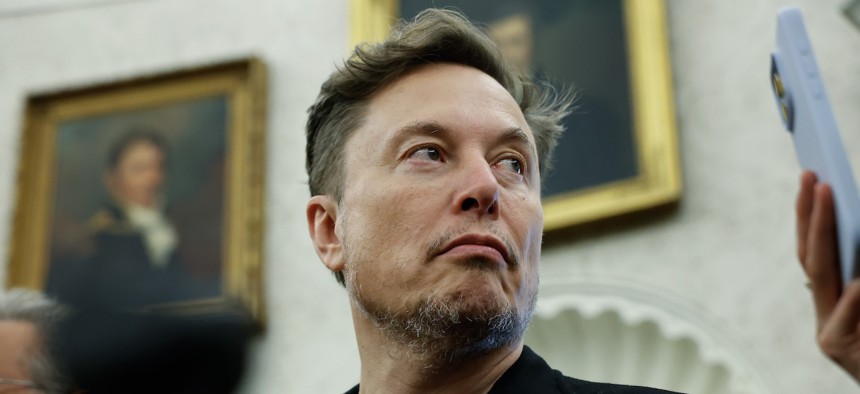
Elon Musk announced on May 28 that he was moving on from DOGE. Chip Somodevilla/Getty Images
For DOGE, it was all in the name
COMMENTARY | Elon Musk made a mockery of government reform.
In retrospect, it was all right there from the beginning, in the name.
The official moniker for Elon Musk’s assault on government—the U.S. DOGE Service—proved to be perfectly fitting for what looks like an already sputtering crusade. It’s a play on an ancient meme that’s more corny than clever, a dad joke masquerading as edgy humor. But what’s really telling is the name of the organization with its acronyms spelled out:
The United States Department of Government Efficiency Service.
That’s what you get when you hijack an existing agency (the U.S. Digital Service) and repurpose it as an inside joke: A name that ironically telegraphs redundancy and is an exercise in self-mockery. It’s altogether fitting that this operation was run by a man who publicly wielded a chainsaw to tout his effort, and in case anyone didn’t get the metaphor, yelled, “This is the chainsaw of the bureaucracy! Chainsaw!”
Musk announced Wednesday that his days leading DOGE were over. But the effort, he said, “will only increase over time.” That’s unlikely. Without a high-profile leader like Musk, DOGE will probably go the way of the many reform efforts that have preceded it, achieving small victories in the background while agencies and White House officials make their own decisions about how to structure their operations and workforces.
In his brief tenure, though, Musk and company wreaked havoc with the federal government and the people who work in it. Some of the DOGE team’s efforts were deliberately terrifying: mass layoffs of federal employees, attempts to unilaterally roll back government spending, and the shutdown of organizations that aren’t even part of the executive branch.
Other DOGE initiatives were simply silly, such as a requirement that all federal employees send a weekly email listing what they had done that week. (That directive, and its empty threat to treat noncompliance as a form of resignation, was so preposterous that many federal entities simply ignored it.)
Musk promised that his effort would deliver unprecedented savings: $2 trillion. That goal was almost immediately slashed in half, and reclassified as more of an aspiration. Then it was rounded down even more drastically, to a mere $150 billion. By mid-May, DOGE claimed to have hit that target, although its math has been dubious.
It was to be expected that the DOGE team didn’t understand, much less respect, the basic principles of American governance. But the group of tech whiz kids Musk assembled didn’t even understand relatively simple technological issues like the Social Security Administration’s database structure, causing them to see hundreds of billions of dollars in fraud that simply wasn’t there.
That’s sad, because there are significant issues with waste, fraud and abuse in federal programs. Musk’s team could have sat down with the folks at the Government Accountability Office to talk about that. Then, working with Cabinet secretaries to wield, in Trump’s terms, a scalpel rather than a hatchet, they could have come up with specific plans to cut waste and fraud, and begun implementing them.
But they didn’t do that. Instead, operating under the assumption that not only waste and fraud, but incompetence, were rampant, the Musketeers descended on agencies and hacked away at spending and staffing. When they hunted for genuine abuse, they rarely found it. When one DOGE staffer assigned to the Department of Veterans Affairs concluded that “the government works. It’s not as inefficient as I was expecting, to be honest,” he was fired.
So far, DOGE has only been successful in one of its objectives: decimating and traumatizing the federal workforce. For that, all of us will pay in both the short and long term.







